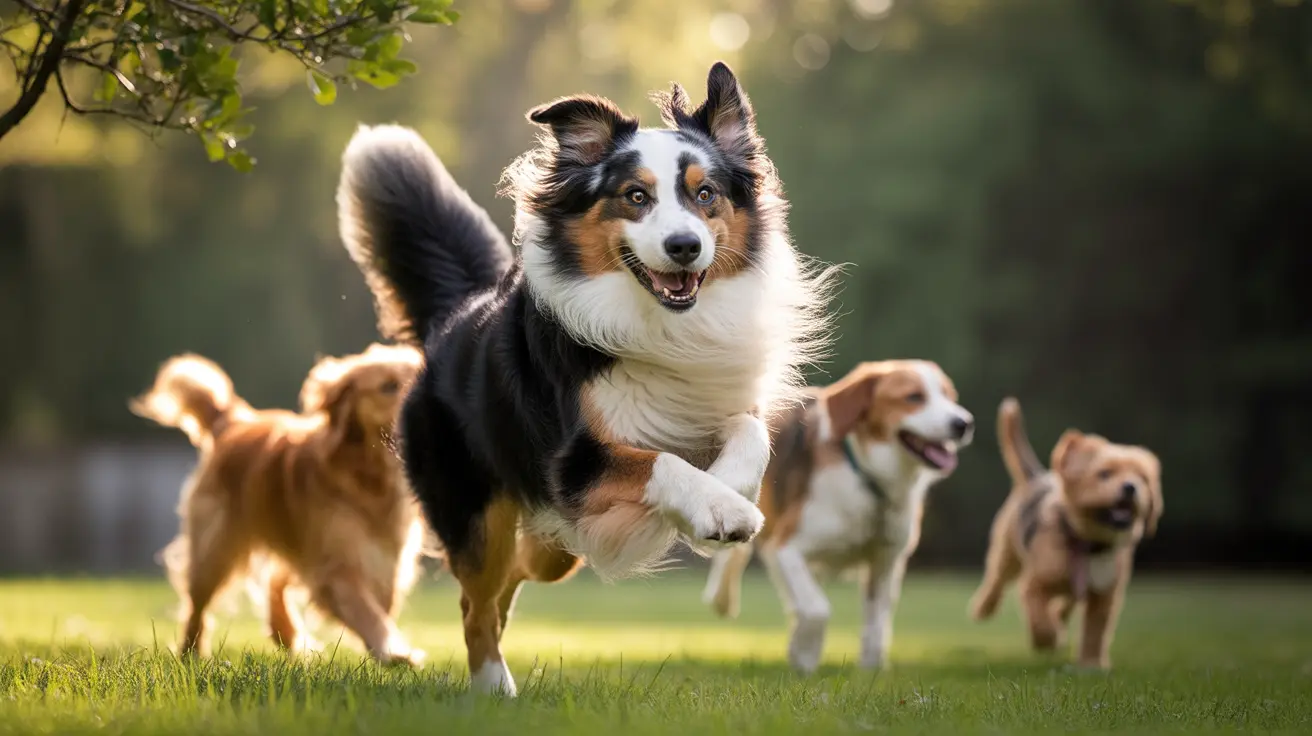Understanding Dog Pack Dynamics: The Key to Harmonious Multi-Dog Households
Dog pack dynamics form the foundation of canine social behavior, yet many pet owners struggle to understand the subtle differences between true pack bonds and casual dog groups. This misunderstanding often leads to behavioral issues, conflicts, and frustrated relationships between dogs and their human families. Whether you're managing a multi-dog household or simply trying to understand your single dog's social needs, grasping the principles of pack structure is essential for creating a harmonious living environment.
The concept of pack behavior in domestic dogs has evolved significantly from early dominance theories, but the underlying social structures remain deeply embedded in canine genetics. By understanding these natural instincts and learning to establish clear leadership without coercion, dog owners can prevent common problems like aggression, resource guarding, and territorial disputes while fostering stronger bonds with their pets.
The Fundamental Difference Between Dog Packs and Casual Groups
A common misconception among dog owners is that any group of dogs that interact regularly constitutes a pack. However, true pack formation requires much deeper social bonds and shared activities that go beyond occasional meetings during walks or playdates.
A genuine dog pack is a closely bonded community that shares essential survival activities together. These activities include eating meals in proximity, sleeping in shared spaces, and collectively defending their territory. Pack members develop intricate communication patterns, establish clear hierarchies, and coordinate their daily activities around the group's needs rather than individual preferences.
In contrast, dogs that simply know each other well or meet regularly for walks remain casual acquaintances rather than pack members. These relationships, while potentially friendly, lack the deep interdependence and shared responsibility that characterize true pack bonds. The distinction becomes particularly important when introducing new dogs or managing group interactions, as casual groups operate under different social rules than established packs.
Behavioral Signs of True Pack Formation
Several key behavioral indicators distinguish authentic pack relationships from casual dog friendships. Pack members typically exhibit synchronized sleeping patterns, often choosing to rest in close proximity even when separate spaces are available. They also demonstrate coordinated alert behaviors, with one dog's alarm response triggering immediate attention from other pack members.
Resource sharing represents another crucial pack indicator. While casual dog groups may compete for toys, food, or attention, true pack members often share resources naturally or defer to established hierarchies without conflict. Additionally, pack dogs show genuine concern for absent members, displaying anxiety or search behaviors when separated from their pack mates.
How Pack Hierarchy Develops in Multi-Dog Households
Within established dog packs, hierarchy development follows distinct patterns based on gender, age, and individual temperament. Female pack hierarchies typically organize around age, with older females naturally assuming leadership roles over younger ones. This age-based structure tends to remain stable over time, creating predictable social order that reduces conflicts.
Male hierarchies operate differently, organizing primarily around strength, assertiveness, and confidence rather than age alone. These hierarchies may shift more frequently than female structures, particularly during adolescence or when pack composition changes. However, contrary to popular misconceptions about constant alpha battles, most hierarchy establishment occurs through subtle body language and positioning rather than overt aggression.
The hierarchy development process typically takes several months in newly formed multi-dog households. During this period, dogs negotiate their positions through various interactions including play styles, feeding behaviors, and responses to environmental challenges. Owners who understand this natural process can facilitate smoother transitions by providing consistent leadership while allowing dogs to establish their internal order organically.
The Role of Age and Experience in Pack Leadership
Age plays a particularly significant role in pack dynamics, though its influence varies between genders and individual personalities. Older dogs often possess valuable experience in reading environmental cues, managing resources, and maintaining group stability, making them natural candidates for leadership positions within the pack structure.
However, physical capability also factors into leadership roles. As senior dogs age and lose physical strength or sensory acuity, younger pack members may gradually assume greater responsibility for territory defense and group coordination. This transition typically occurs gradually and peacefully when pack bonds are strong and human leadership remains consistent.
Establishing Yourself as the Pack Leader
Modern understanding of pack leadership emphasizes calm, consistent guidance rather than dominance-based control. Effective pack leadership involves establishing clear rules, providing predictable routines, and making important decisions about the pack's daily activities without resorting to intimidation or harsh corrections.
Successful pack leaders control access to valuable resources including food, toys, sleeping areas, and social interactions. This doesn't mean withholding these resources, but rather ensuring that dogs understand these privileges come through the human's permission and can be managed when necessary. For example, dogs should wait for permission before eating, entering certain areas, or greeting visitors.
Consistency across all family members is crucial for maintaining pack leadership. When different household members apply different rules or boundaries, dogs may become confused about the hierarchy or attempt to exploit inconsistencies. Regular family discussions about dog rules and boundaries help ensure everyone reinforces the same expectations.
Practical Leadership Strategies
Effective pack leadership begins with controlling movement and space. Dogs should move out of pathways when humans approach, wait at doorways for permission to proceed, and respect boundaries around human furniture or restricted areas. These expectations establish spatial respect without confrontation.
Meal management provides another excellent opportunity for demonstrating leadership. Dogs should remain calm and wait for permission before approaching food bowls, and owners should be able to handle food bowls without defensive responses. This practice prevents resource guarding while reinforcing the human's role in providing essential resources.
The Psychology of Pack Boundaries and Territory
Clear pack boundaries provide dogs with essential psychological security by defining their social group and territory. When boundaries become unclear or frequently change, dogs often experience stress, anxiety, and behavioral problems as they struggle to understand their role and responsibilities within the group.
Territorial behavior in domestic dogs stems from their genetic inheritance of territory defense instincts. However, in human households, dogs must learn that humans control territorial decisions, including who may enter the property, when other dogs may visit, and how group interactions are managed. Dogs who understand these boundaries typically show less anxiety and aggression toward visitors or unfamiliar dogs.
The psychological impact of unclear boundaries often manifests as excessive alerting, resource guarding, or difficulty settling in the presence of visitors or new dogs. Dogs need to understand that their human pack leaders will handle territory management, allowing them to relax rather than constantly monitor for potential threats or challenges to pack stability.
Managing Stress from Boundary Disruptions
When pack boundaries are disrupted through moves, new additions, or changes in household composition, dogs may experience significant stress that manifests in various behavioral changes. Common stress indicators include increased marking, changes in appetite, disrupted sleep patterns, or heightened reactivity to environmental stimuli.
Supporting dogs through boundary changes requires increased structure, consistent routines, and clear communication about new expectations. Providing familiar items like bedding or toys helps maintain some continuity while dogs adapt to new territorial or social arrangements.
Differences Between Wild and Domestic Dog Pack Dynamics
Modern scientific understanding reveals significant differences between wild wolf packs and domestic dog groups. Natural wolf packs are typically nuclear family units consisting of breeding parents and their offspring, rather than unrelated individuals competing for dominance. This family-based structure operates quite differently from the complex multi-dog households common in domestic settings.
Domestic dogs have undergone thousands of years of selective breeding that has modified their social behaviors, physical characteristics, and relationship patterns with humans. While they retain pack instincts, domestic dogs show greater flexibility in forming bonds with unrelated individuals and integrating into human-led social structures than their wild counterparts.
The domestication process has also enhanced dogs' ability to read human social cues and form interspecies pack bonds. This adaptation allows dogs to accept human leadership more readily than wolves while maintaining their natural inclination toward hierarchical social organization.
Implications for Modern Dog Training
Understanding these evolutionary differences has significant implications for training approaches. Early dominance-based training methods based on outdated wolf studies often proved counterproductive because they failed to account for the unique characteristics of domestic dogs and their enhanced capacity for cooperative relationships with humans.
Modern training emphasizes positive reinforcement and clear communication rather than intimidation or force. This approach recognizes that domestic dogs are motivated by cooperation and resource access rather than fear of punishment, making training more effective and strengthening the human-dog bond.
Safe Socialization and Group Management
Managing dog socialization safely requires understanding the difference between pack integration and casual social interactions. When dogs from different households meet, they maintain their separate pack loyalties while engaging in temporary social activities. These interactions require careful supervision to prevent misunderstandings or conflicts between groups with different social rules.
Successful group walks or dog park visits depend on maintaining clear human leadership throughout the interaction. Dogs should remain responsive to their owners' directions and be easily recalled if tensions arise. Owners must also recognize when their dogs are becoming overstimulated or stressed and remove them from the situation before conflicts develop.
Group activities work best when all participating dogs have solid basic training and clear pack relationships with their respective owners. Dogs who lack clear leadership at home often struggle in group settings because they may attempt to establish inappropriate hierarchies with unfamiliar dogs or fail to respond to their owner's guidance when needed.
Reading Dog Body Language in Groups
Successful group management requires the ability to read subtle canine communication signals that indicate comfort, stress, or potential conflict. Relaxed dogs typically display loose body postures, play bows, and alternating chase behaviors during positive interactions. Signs of tension include stiff postures, prolonged staring, resource guarding, or mounting behaviors that may escalate to conflicts.
Early intervention when tension signals appear can prevent many conflicts. Redirecting attention, creating physical space between dogs, or temporarily removing overstimulated individuals allows situations to de-escalate naturally without traumatic confrontations that could damage future social relationships.
Introducing New Dogs to Established Packs
Successfully integrating a new dog into an established pack requires careful planning and gradual introduction processes. The existing pack must first accept the newcomer's presence in their territory before pack bonds can develop. This process typically takes weeks or months rather than days, and rushing integration often leads to conflicts or rejection.
Initial introductions should occur on neutral territory away from the established pack's home base. Multiple brief, positive interactions help dogs become familiar with each other without the pressure of immediate territory sharing. Gradually moving interactions closer to home allows the existing pack to maintain some territorial control while evaluating the newcomer's compatibility.
During the integration period, maintaining separate resources like food bowls, sleeping areas, and toys prevents competition that could undermine developing relationships. As comfort levels increase and initial hierarchies establish, dogs may naturally begin sharing resources, but this should occur organically rather than being forced by human intervention.
Signs of Successful Pack Integration
Successful pack integration becomes apparent through several behavioral changes. Dogs begin choosing to rest near each other voluntarily, showing coordinated alert responses to environmental stimuli, and demonstrating concern when pack members are absent. Play behaviors become more relaxed and reciprocal, with dogs taking turns in different roles rather than maintaining rigid dominant-submissive patterns.
The integration process is complete when dogs function as a cohesive unit that responds collectively to human leadership while maintaining their internal social structure. At this stage, the pack can participate in group activities, share common spaces comfortably, and support each other during stressful situations.
Frequently Asked Questions
- How long does it take for dogs to form a true pack bond?
True pack bonds typically develop over several months of shared living, eating, and sleeping experiences. Casual friendships may form quickly, but the deep interdependence characteristic of pack relationships requires extended time together and shared experiences. Most multi-dog households see initial pack formation within 3-6 months, though complete integration may take up to a year.
- Can dogs from different households ever form a pack together?
Dogs from separate households rarely form true pack bonds because they don't share the essential daily activities that create pack relationships. However, they can develop strong friendships and enjoy temporary pack-like activities during group walks or playdates. The lack of shared territory and resources prevents the deep interdependence that characterizes true packs.
- What should I do if my dogs are fighting over pack hierarchy?
Persistent fighting usually indicates unclear human leadership rather than normal hierarchy establishment. Dogs typically negotiate hierarchy through subtle body language rather than overt aggression. Increase your leadership presence by controlling resources, establishing clearer rules, and seeking professional help if conflicts continue. Never allow dogs to "work it out" through fighting, as this can escalate to serious injuries.
- Is it necessary to eat before my dogs to maintain pack leadership?
Eating order is less important than controlling access to food resources. While some dogs respond well to humans eating first, the key is ensuring dogs wait calmly for permission to eat and remain non-possessive around food bowls. Focus on teaching patience and impulse control rather than rigid eating hierarchies.
- How do I know if my dog sees me as the pack leader?
Dogs who accept human leadership typically respond promptly to direction, move out of pathways when humans approach, and remain calm during resource management. They also look to humans for guidance during uncertain situations rather than making independent decisions about territory defense or social interactions.
- Can pack dynamics change when dogs age?
Pack hierarchies naturally shift as dogs age, particularly when older leaders lose physical capabilities or younger dogs mature. These transitions usually occur gradually and peacefully when human leadership remains consistent. However, significant changes like illness or the death of a pack member may temporarily disrupt established hierarchies until dogs readjust their relationships.
- Should I intervene when my dogs are establishing hierarchy?
Allow dogs to establish internal hierarchies through normal body language and positioning, but intervene if interactions become aggressive or destructive. Provide consistent human leadership while letting dogs work out their relationships naturally. Most hierarchy establishment involves subtle communications rather than dramatic confrontations, so obvious conflicts usually indicate other underlying issues.
Conclusion
Understanding dog pack dynamics provides the foundation for creating harmonious relationships in multi-dog households and improving single-dog behavior management. True pack bonds develop through shared daily experiences and deep social interdependence, distinguishing them from casual dog friendships or temporary group interactions. By establishing clear, consistent leadership without resorting to dominance or intimidation, owners can guide their dogs' natural pack instincts in positive directions.
Success in managing pack dynamics requires patience, consistency, and respect for dogs' natural social needs while maintaining appropriate human leadership. Whether introducing new dogs to existing packs or simply working to strengthen the bond with a single pet, understanding these principles helps create the security and structure that dogs need to thrive in human households. Remember that every dog and situation is unique, and professional guidance can be invaluable when dealing with complex pack integration challenges or persistent behavioral issues.





